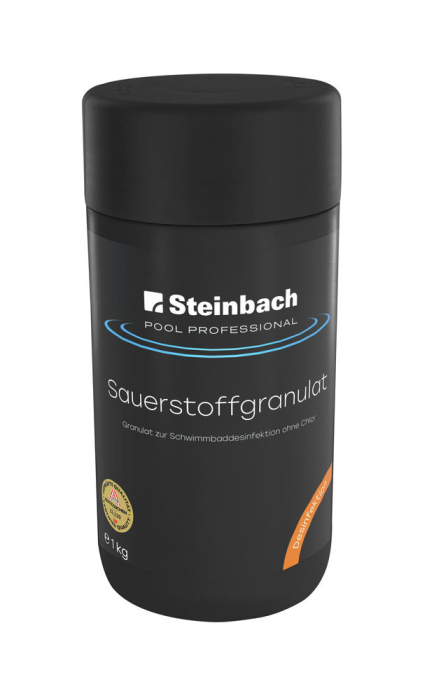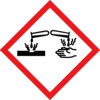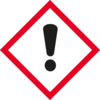Oxygen granules
- Rapid disinfection and oxidation of impurities without chlorine
- Well soluble compound
- Cleaves active oxygen in aqueous solution
- Switching from chlorine to active oxygen is possible at any time
- Field of application: initial dosing and long-term dosage
Sold Out
The selected product is currently not available. As soon as the product is on stock, we will send you an E-mail.

Product information
Granules for swimming pool disinfection without chlorine
Oxygen granules, 1,00 kg, UN3260, Acute Tox. 4, Skin Corr. 1B, Eye Dam. 1, Aquatic Chronic 3
USAGE: Water care product for disinfection and algae growth prevention. Granules for rapid disinfection and oxidation of impurities without chlorine. Well soluble compound, which cleaves active oxygen in aqueous solution. Switching from chlorine to active oxygen is possible at any time.
For private swimming pools only.
Only use a dosage floater, skimmer or dosage feeder.
DOSAGE: Before adding Oxygen granules, adjust pH-value to the optimal range of 7.0 - 7.4. The oxygen value should be between 5.0 und 10.0 mg/l. For initial dosage, 200g (ca. 200ml)/10m³ Oxygen granules and additionally 100-150ml/10m³ oxygen activator liquid. On a weekly basis, dissolve 100 g (ca. 100 ml) of oxygen granules per 10 m³ of water volume in water, add the mixture to the pool ideally via a skimmer and add 40-50 ml of liquid oxygen activator per 10 m³ of water volume to the pool near the inlet nozzles. In the case of cloudy water after frequent use, thundershower or high temperatures add 400g (ca. 400ml)/10m³ Oxygen granules to the pool water.


FAQs from category Active oxygen:
If you put the chlorine tablets directly into the water, the chlorine will attack the liner, discolouring it and making it brittle. Irreversible damage not covered by any warranty may occur. All our dosing floats have an adjustment ring - to adjust the release to the pool water. Alternatively, you can also put the tablets into the skimmer.
The ideal pH value is between 7.0 and 7.4. If the pH value is too high (above 7.4) the water tends to form lime deposits (turbidity of the water). Eye and skin irritation could occur. The disinfection effect could also be reduced. If the value is too low (below 7.0), the water becomes increasingly corrosive. Odour nuisance and irritation of the mucous membranes may occur. We recommend measuring the value twice a week. For pH regulation we recommend 'ph + (plus) granules' or 'ph - (minus) granules'.
The ideal chlorine value is in the range of 0.3-0.6 mg/l. The measurement should be taken 1-2 times per week. If the value is too high, bathing is not recommended. If the value is in the lower range, we recommend products such as Chlorine Tabs 20, Chlorine Tabs 200, Quattrotabs 200, Total Blue 20 as continuous dosing.
Your chlorine level seems to be clearly too high - these tablets react up to a maximum concentration of 6 mg/l. Dilute the water taken and test again. If the values are too high, reduce them to a normal level (0.3 - 0.6 mg/l). After a shock chlorination the test is also not possible. Please wait a few hours.
Cause: Lime precipitates, not filtered particles
Solution: Adjust the pH level to 7.2 to 7.4 (by adding pH-Plus or pH-Minus). If there are suspended matters turn off the circulation pump and remove the flakes on the bottom with the pool cleaner after about 10-12 hours. Lime precipitates in the pool water (turbidity, shimmering white coating on the water surface, etc.) usually disappear shortly after adjusting the pH level and after the addition of a flocculants (while the filter system is running - WARNING: prohibited with cartridge filter systems and filter balls; the filter can stick!). Backwash thoroughly. Clean cartridge filter or replace by a new one.
Possible Causes: Faulty filter function, too many organic substances
Solution: Backwashing. If the filter system is calcified, use an acidic filter cleaner. If the filter system is ok, make a shock chlorination, meaning raise the chlorine level of the pool water up to 3 mg/l for a short time. The addition of flocculant is recommended as an additional measure (WARNING: prohibited with cartridge filter systems and filter balls; the filter can stick!). Backwash thoroughly. Clean cartridge filter or replace by a new one.
Possible cause: Too little disinfectant in the water, algae growth
Solution: Adjust the pH level to 7.2 to 7.4 by adding pH-Plus or pH-Minus. Let the filter system run continuously during the first 1-2 days. For disinfection with chlorine: Wipe dead algae from the pool walls. Remove algae from bottom with a brush and an aspirator. Make a shock chlorination, meaning raise the chlorine level of the pool water up to 3 mg/l. The addition of an algae protection is recommended. Backwash thoroughly. The added chlorine has degraded after a few days. Backwash thoroughly. If the water is not clear after 1-2 days, repeat the procedure. Cartridge filter system: Frequently clean or replace the cartridge. Alternatively, empty the pool completely, clean thoroughly and refill. After adjusting the pH value, treat the pool water with algicide to prevent new algae grow.
Possible cause: Iron deposits in the water
Solution: Adjust the pH level to 7.2 to 7.4 by adding pH-Plus or pH-Minus. Add flocculant. (WARNING: prohibited with cartridge filter systems and filter balls; the filter can stick!) Extend the filter runtime, backwash the filter system thoroughly. In the case of a cartridge filter system, clean the cartridge regularly and replace it if necessary.
Possible cause: Inadequate chlorine dosing, non-degraded organic substances
Solution: Adjust the pH level to 7.0 to 7.4 by adding pH-Plus or pH-Minus. After a shock chlorination up to ca. 3 mg/l this smell will disappear after a short time.
Possible cause: Inadequate chlorine dosing, non-degraded organic substances
Solution: Adjust the pH level to 7.0 to 7.4 by adding pH-Plus or pH-Minus. If there is too little chlorine in the water, increase the chlorine content. If the chlorine content is too high, reduce the dosage or drain the pool water and refill with fresh water. Again, pay attention to the pH value.
Take a bucket of warm water, add the required amount of chemical for your pool and stir well. Then empty the bucket with the mixture evenly into the pool with the filter system switched on (circulating).
The lid of our chemical articles also serves as a dosing aid.
Our chemistry must be equipped with a safety lock for the protection of children. This requires some strength to open.
Safety data sheets are stored with the respective chemical article on our homepage. If you still cannot find what you are looking for, please contact us via our form on our helpdesk.